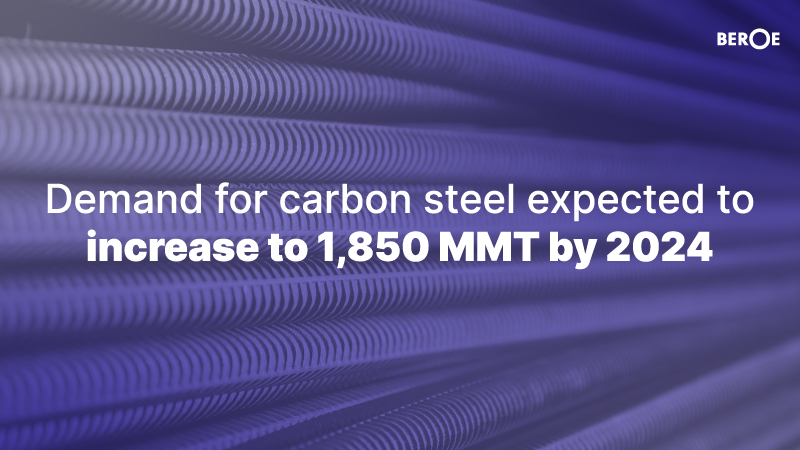Demand for carbon steel expected to increase to 1,850 MMT by 2024, says Beroe
Source: PR Newswire

Mar 15, Raleigh, NC - Several factors, including global economic conditions, government regulations, and trends in construction and manufacturing, will likely influence the outlook for carbon steel production in 2023-24.
In general, a strong global economy and increased demand for construction and manufacturing products are likely to drive carbon steel production. However, government regulations and environmental concerns may also play a role in shaping the industry, as there may be pressure to shift towards more sustainable production methods.
Overall the outlook for carbon steel production will be subject to change based on the above factors and their evolution over time.
That being said, Carbon steel production is segmented into the following four categories:
- Type (Low Carbon Steel, Medium Carbon Steel, High Carbon Steel, Ultra-High Carbon Steel)
- Application (Shipbuilding, Construction, Automotive, Others)
- Product (Carbon Steel, Alloy Steel, Stainless Steel)
- Shape (Long Steel, Tubular Steel, Flat Steel)
Due to the uncertain macroeconomic environment, the impending energy crisis, and the unstable geopolitical prospects, crude and carbon steel market price volatility is anticipated to last over the long term. The global crude steel production for 2023 will increase by 3% compared to 20212(1874.5 million metric tons) (MMT).
By 2024, the carbon steel demand is expected to increase to 1,850 MMT. The fact that decarbonization drives the steel sector will also cause changes in the feedstock markets. The production rate will likely expand at a 1-2 percent CAGR from 2021 to 2025.
Here are some market trends that will influence the prognosis for "Carbon steel production" in 2023 - 2024,
The dominance of China over the Asia- Pacific region:
Thanks to the expansion of the shipbuilding industry, there's been an increased demand for carbon steel in industries like construction and automobiles. In addition, there's a huge influx of companies competing with each other in the market.
As a result, China firmly holds a monopoly over the Asia-Pacific carbon steel market.
Steel is generally exported from Asia and is oversupplied in other parts of the world. However, North America and Europe are currently experiencing a steel deficit because they import steel. At the same time, some areas have managed to recover from the pandemic. The after-effects in 2021 there have been more covid related outbreaks that have disrupted the supply chain of carbon steel that is yet to be healed.
In 2021, some regions were able to recover from the post-pandemic shock. However, there have been new COVID outbreaks globally, indicating that the supply chain disruption is still not fully recovered.
Uncertain macroeconomic environment
Price volatility is expected to persist over the long run due to the ambiguous macroeconomic climate, the coming oil crisis, and the unclear geopolitical outlook.
Compared to 2022 (1875.5 metric million tonnes), the world's crude steel production will grow by 3% in 2023. (Mt).
It must be noted that despite a small increase in demand, the Russia-Ukraine war has impacted the infrastructure and construction supply chains.
Fluctuating Prices
Based on the insights collected during the course of this report, the prices are projected to vary throughout the projection period.
The price of carbon steel products in the U.S. is predicted to increase from 782 USD/MT in January 2023 to 905 USD/MT by December 2023. Due to the approaching Thanksgiving holiday season, demand is anticipated to be weak in the market. For instance, U.S. appliance maker Whirlpool from Michigan also cut its production by 35 percent during this quarter.
Whereas in China, the price of carbon steel production can be seen increasing to 785 USD/MT by the end of the year 2023. The challenges of insufficient demand, existing inventories, limited cash, and growing credit availability is expected to add upward pressure on prices.
Feedstock prices are expected to drop in the short term. For instance, iron ore prices will decrease by 1 – 2 percent in the short term.
Owing to a depreciating Chinese yuan, compared with the U.S. dollar, prices of the hot-rolled coil are expected to reduce by around 2 – 3 percent in the short term.
Growing disposable income & infrastructural development:
During the anticipated period, the carbon steel market will expand due to factors such as quick urbanization, rising disposable income levels, expanding usage of innovative lightweight composites for new-generation aircraft, and an increase in environmental concerns.
The rising number of infrastructure developments, rising usages of the product in pipelines, frame materials, gates, fencing, and other applications, rising demand for polymer foams, and rising number of applications from aerospace and other end-use industries are some of the vital and impactful factors that result in the growing infrastructure.
Restraints
The difficult manufacturing process and use is a significant element that is anticipated to restrain market revenue growth. Due to its tremendous strength and brittleness, carbon steel presents a difficult working environment. Its use is restricted in several applications due to the material's difficulties in being twisted and molded into different shapes. Carbon steel is more susceptible to rust and corrosion than other kinds of steel.
The biggest and most immediate obstacle to the market's expansion will be the ease with which product alternatives can be found.
Volatility in the prices of lightweight materials, combined with a decreasing steel capacity utilization ratio, will most likely act as market restraints for the growth of carbon steel during the forecasted timeframe.
Due to steel supply limitations, the steel market is currently facing its largest challenge: rising prices. However, options to move the manufacturing base to an Asian demand hub present the same difficulty.
A good starting point is to begin with, small to medium contracts with vendors while also trying to disregard the impact of price fluctuations while sourcing steel.
For more such market data, insights, and intelligence check out Beroe LiVE.Ai™.
About Beroe
Beroe is a global SaaS-based procurement intelligence and analytics provider. We deliver intelligence, data, and insights that enable companies to make smarter sourcing decisions – leading to lower cost, reduced risk, and greater profits. Beroe has been a trusted source of intelligence for more than 15 years and presently partners with 10,000 companies worldwide, including 400 of the Fortune 500 companies. For more information about Beroe Inc., please visit https://www.beroeinc.com/.
Media Contact:
Rob McMurtrie
rob.mcmurtrie@beroe-inc.com
Related News
View all
Beroe Makes Strategic Investment in Forestreet, Strengthening AI Capabilities and Driving Procurement Intelligence Innovation

Beroe introduces on-demand geopolitical risk analysis through PRISM enabling C-Suite to protect against ongoing supply chain disruptions
